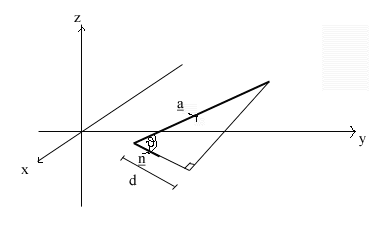Definition
The dot product of a and b, written a.b, is defined by
a.b = a b cos q
where a and b are the magnitudes of a and b and q is the angle between the two vectors that satisfies,
0 O q O p

The dot product is distributive:
a.(b + c) = a.b + a.c
and commutative:
a.b = b.a
Knowing that the angles between each of the i, j, and k vectors is p/2 radians (90 degrees) and cos p/2 = 0, we can derive a handy alternative definition: Let,
u = ai + bj + ck
v = xi + yj + zk
then,
u.v = (ai + bj + ck).( xi + yj + zk)
=>u.v = (ai + bj + ck). xi +
(ai + bj + ck).yj +
(ai + bj + ck).zk
The angle between any nonzero vector and iteself is 0, and cos 0 = 1, so i.i = 1 etc., Hence,
u.v = a x + b y + c z
This means that for any vector, a,
a. a = a2
Finding the angle between two vectors
We can now, given the coordinates of any two nonzero vectors u and v find the angle q between them:
u = ai + bj + ck
v = xi + yj + zk
u.v = u v cos q
u.v = a x + b y + c z
=> u v cos q = a x + b y + c z
=> q = cos-1 o (a x + b y + c z) / ( u v ) p
To get used to this method check out this applet
What would happen if one of the vectors was the null vector 0, from (0,0,0) to (0,0,0). This is the only vector without a direction and it isn't meaningful to ask the angle between this vector and another vector. How does our method fail if we try?
One of the main uses of the dot product is to determine whether two vectors, a and b, are othogonal (perpendicular).
If a . b = 0, then either,
a is orthogonal to b, or
a = 0, or
b = 0.


